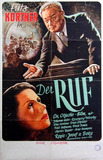Film clip from Das Testament des Dr. Mabuse [The Testament of Dr. Mabuse] (1932/33)
Film clip from Das Testament des Dr. Mabuse [The Testament of Dr. Mabuse] (1932/33)
When in 1922, I made my first Mabuse film I called it ‘Dr. Mabuse – the Gambler, a picture of our time’ ... and I believe that all my films are somehow a picture of their time.
Fritz Lang looking back, quoted by Lotte Eisner: Fritz Lang, 1976
The third of Fritz Lang’s films about the genius criminal Dr. Mabuse was also his last German directorial work before the Second World War. Immediately after completion in March 1933, Das Testament des Dr. Mabuse was banned by the Nazis. The film was “seditious” and a “textbook for the preparation to commit terroristic acts” – above all for the impotent communists.
Although the mad criminal Dr. Mabuse has since been committed to the insane asylum run by Professor Baum, his criminal energy remains unbroken. Using telepathic abilities, he manipulates the people around him and spreads fear and chaos even after his death. A plot that would plunge the world into chaos only just fails to come to fruition – thus the film, in retrospect, looks like a warning against the mechanisms of the abuse of power and the hubris of human striving for power, which only months later would become German reality. Lang has the clinic director, who increasingly falls victim to the telepathic influence of Dr Mabuse, speak words that recall the programmatic speeches of fanatic nationalists.
Although the film must be seen as a parable and not an anti-Nazi film, it clearly met with a climate in which scenes like the aforementioned were regarded as dangerous. The director and numerous workers on the film, including cutter Lothar Wolff, leading actor Oskar Beregi Sr and producer Seymour Nebenzahl went into exile shortly thereafter.




